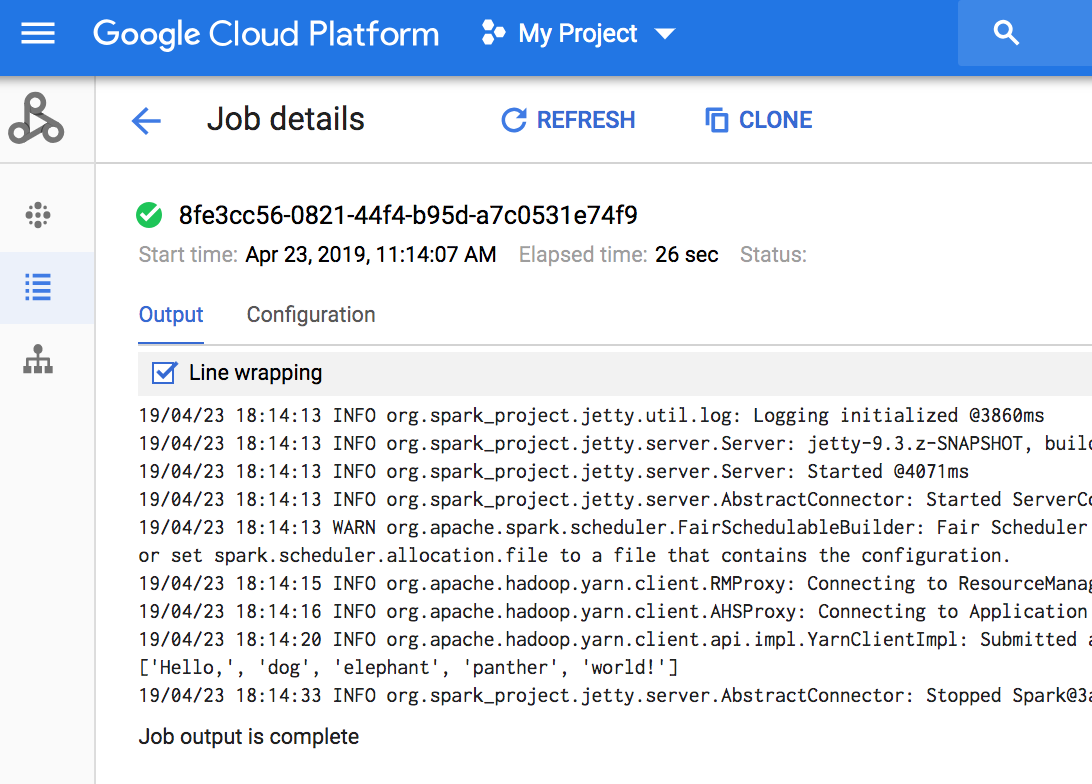Membuat cluster Dataproc menggunakan library klien
Contoh kode yang tercantum di bawah menunjukkan cara menggunakan Cloud Client Libraries untuk membuat cluster Dataproc, menjalankan tugas di cluster, lalu menghapus cluster.
Anda juga dapat melakukan tugas ini menggunakan:
- Permintaan REST API di Mulai Cepat Menggunakan API Explorer
- konsol Google Cloud di Membuat cluster Dataproc menggunakan konsol Google Cloud
- Google Cloud CLI di Membuat cluster Dataproc menggunakan Google Cloud CLI
Sebelum memulai
- Sign in to your Google Cloud account. If you're new to Google Cloud, create an account to evaluate how our products perform in real-world scenarios. New customers also get $300 in free credits to run, test, and deploy workloads.
-
In the Google Cloud console, on the project selector page, select or create a Google Cloud project.
Roles required to select or create a project
- Select a project: Selecting a project doesn't require a specific IAM role—you can select any project that you've been granted a role on.
-
Create a project: To create a project, you need the Project Creator
(
roles/resourcemanager.projectCreator), which contains theresourcemanager.projects.createpermission. Learn how to grant roles.
-
Verify that billing is enabled for your Google Cloud project.
-
Enable the Dataproc API.
Roles required to enable APIs
To enable APIs, you need the Service Usage Admin IAM role (
roles/serviceusage.serviceUsageAdmin), which contains theserviceusage.services.enablepermission. Learn how to grant roles. -
In the Google Cloud console, on the project selector page, select or create a Google Cloud project.
Roles required to select or create a project
- Select a project: Selecting a project doesn't require a specific IAM role—you can select any project that you've been granted a role on.
-
Create a project: To create a project, you need the Project Creator
(
roles/resourcemanager.projectCreator), which contains theresourcemanager.projects.createpermission. Learn how to grant roles.
-
Verify that billing is enabled for your Google Cloud project.
-
Enable the Dataproc API.
Roles required to enable APIs
To enable APIs, you need the Service Usage Admin IAM role (
roles/serviceusage.serviceUsageAdmin), which contains theserviceusage.services.enablepermission. Learn how to grant roles. - Instal library klien Untuk mengetahui informasi selengkapnya, lihat Menyiapkan lingkungan pengembangan Anda.
- Menyiapkan autentikasi
- Clone dan jalankan kode GitHub contoh.
- Lihat outputnya. Kode ini akan menghasilkan log driver tugas ke
bucket penyiapan
Dataproc default di Cloud Storage. Anda dapat melihat output driver tugas dari konsol Google Cloud
di bagianTugas
Dataproc project. Klik ID Tugas untuk melihat output tugas di halaman Detail tugas.

- Instal library klien Untuk mengetahui informasi selengkapnya, lihat Menyiapkan Lingkungan Pengembangan Java.
- Menyiapkan autentikasi
- Clone dan jalankan kode GitHub contoh.
- Lihat outputnya. Kode ini akan menghasilkan log driver tugas ke
bucket penyiapan
Dataproc default di Cloud Storage. Anda dapat melihat output driver tugas dari konsol Google Cloud
di bagianTugas
Dataproc project. Klik ID Tugas untuk melihat output tugas di halaman Detail tugas.

- Instal library klien Untuk mengetahui informasi selengkapnya, lihat Menyiapkan lingkungan pengembangan Node.js.
- Menyiapkan autentikasi
- Clone dan jalankan kode GitHub contoh.
- Lihat outputnya. Kode ini akan menghasilkan log driver tugas ke
bucket penyiapan
Dataproc default di Cloud Storage. Anda dapat melihat output driver tugas dari konsol Google Cloud
di bagianTugas
Dataproc project. Klik ID Tugas untuk melihat output tugas di halaman Detail tugas.

- Instal library klien Untuk mengetahui informasi selengkapnya, lihat Menyiapkan Lingkungan Pengembangan Python.
- Menyiapkan autentikasi
- Clone dan jalankan kode GitHub contoh.
- Lihat outputnya. Kode ini akan menghasilkan log driver tugas ke
bucket penyiapan
Dataproc default di Cloud Storage. Anda dapat melihat output driver tugas dari konsol Google Cloud
di bagianTugas
Dataproc project. Klik ID Tugas untuk melihat output tugas di halaman Detail tugas.

- Lihat Library Klien Cloud Dataproc Referensi tambahan.
Jalankan Kode
Coba panduan: Klik Open in Cloud Shell untuk menjalankan panduan Library Klien Cloud Python yang membuat cluster, menjalankan tugas PySpark, lalu menghapus cluster.

